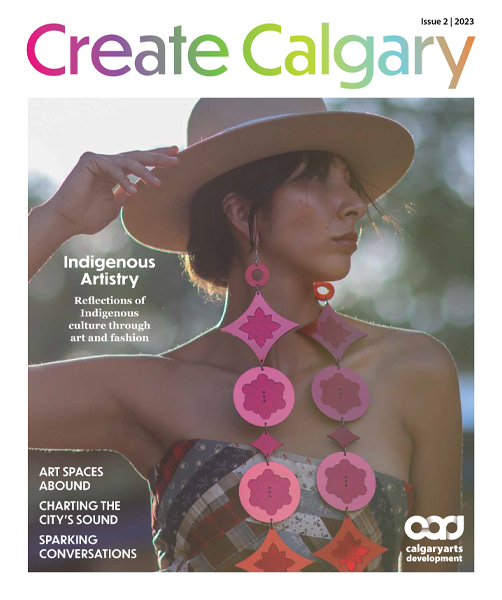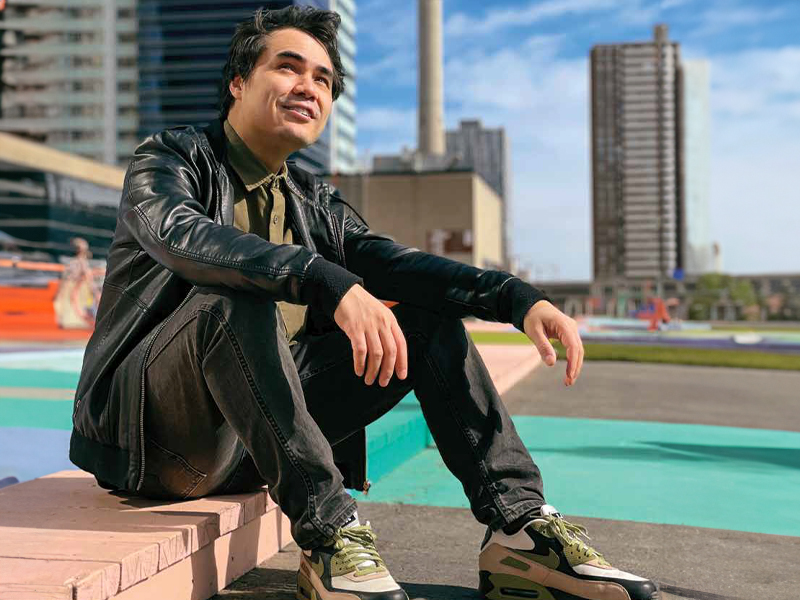Portfolio: Jarett Sitter
Calgary artist Jarett Sitter offers insight into his creative process and shares some behind-the-scenes tidbits about his latest project in Chinatown, The Bison and The Dragon: Untold Tales
Jarett Sitter is a freelance illustrator/animator working in Calgary. He has created animations and post-production work for music videos that have been nominated for JUNO Awards and MuchMusic Video Awards. In 2021, he was selected as the City of Calgary Centre City Banner Program artist, where his banner designs were installed and featured around the downtown area. Here, Sitter shares more about the process behind his latest project, The Bison and The Dragon: Untold Tales.
“I grew up drawing all the time and was really inspired by skateboarding graphics, music, album covers, Saturday morning cartoons and fairy tale stories. I definitely try to play with some of those nostalgic elements in my art. I like creating weird little worlds for my characters to live in and create a sense of discovery and characters that are curious about the environment.”

Artwork courtesy of Jarett Sitter
PROJECT BACKGROUND
The Bison and The Dragon: Untold Tales was originally planned as a road mural to help slow traffic and add vibrancy to the streets of Chinatown. During an engagement meeting between Sitter and the Calgary Chinese Elderly Citizens’ Association, it was brought to attention that painting on the road could be culturally insensitive because, to some Chinese residents of the area, a road mural is reminiscent of “villain hitting,” which is a ritual act of cursing a person by walking on or hitting with a shoe a piece of paper with their information or image of their likeness. As a result, the project was changed to instead feature three illustrations installed on the exterior walls of the Pho City and Calgary Immigrant Women’s Association buildings in Chinatown.
“The call for the project stipulated that the artwork should have to do with the history of the land, both Chinatown as well as the First Nations peoples who were the original stewards of the land and the idea of Truth and Reconciliation,” says Sitter. “So those were all elements that I went into the project knowing were an expectation. I had the fortunate opportunity to speak with First Nations Elders, which was a big part of the process. Then I spoke with the community, building owners, business owners, community leaders and people visiting Chinatown. “This project is the most community engagement that I’ve ever done. I talked to hundreds of people to get their viewpoints and input. I’m part Chinese, part German Polish, so my experiences as being mixed heritage also inspired all the artwork involved.”
THE PROCESS
“One of the goals of the project was to talk about not only Chinatown but First Nations peoples as well and the friendships and relations there that could be spoken about. During an exhibit I did with Lougheed House called We Were Here: Stories from Early Chinatown, I learned of the stories of how the First Nations peoples would help early Chinese immigrants working on the railroads to survive the elements by providing shelter and how the Chinese would help feed the First Nations peoples when they weren’t allowed into whiteowned establishments. So, I became interested in those relationships and this unique Canadian experience that is not often talked about.

Left: Process artwork, Artwork
Courtesy of Jarett Sitter
“I wanted to blend different elements from different cultures, such as the mythical creatures associated with the Chinese, the dragon and the phoenix. Often, the dragon is depicted as an amalgamation of different animals, like an eagle’s talons or a deer’s antlers. So, I had the idea to incorporate the bison, an important animal to the First Nations people, into the dragon in a significant way. The whole thing is a dragon, but it has the head of a bison.
“For the second piece, I wanted to bring in the phoenix as it’s often paired with the dragon as the Yin and Yang. The Yang dragon represents masculinity, and the Yin phoenix represents the feminine. One of the buildings is the Calgary Immigrant Women’s Association, so it was important to have the organization and the women that come through their organization represented. So the phoenix represents the feminine as well as this idea of an immigrant story being told through the phoenix as a bird in flight, moving locations and representing the beginning of a new era.
“The last piece in the series is the guardian lion. These lions are also depicted in pairs representing Yin and Yang, with the male usually holding a ball representing the material world and the female with a cub represents the cycle of life. In my depiction, one of the lions is a bear, speaking to the relationship between the First Nations and early Chinese immigrants, who would often marry and start families together. The cub represents these mixed heritage children, who are not often thought about, as well as the Canadian-born Chinese.
“My hope is that people can talk about this more and learn more about it and join in with that celebration of history and culture and maybe even be inspired to share their stories.”
Learn more about the artist at jaretts.com.

Left: Process artwork, Artwork
Courtesy of Jarett Sitter
VALUE OF BISON
In Indigenous culture, the bison provided essential food and raw materials, and became a fundamental part of life. Symbolically, the bison represents protection, stability, prosperity, courage, strength, freedom, abundance and gratitude. The birth of a white bison is considered both sacred and spiritually significant — a sign of hope and good times to come.
THE DRAGON AND PHOENIX
In Chinese culture, the dragon has long been seen as the most important symbol of power and a bringer of good luck. Historically, the Chinese dragon is associated with the Emperor of China and represents imperial power. The phoenix represents power sent from the heavens to the Empress and symbolizes luck. Together the dragon and phoenix represent Yin and Yang.
This article has been updated from the original version published in the 2023 edition of Create Calgary, an annual magazine launched by Calgary Arts Development in 2022 to celebrate the work of artists who call Mohkinsstsis/Calgary home.
You can pick up a free copy at public libraries, community recreation centres and other places where you find your favourite magazines. You can also read the digital version online here.

